These Century-Old Photos from National Geographic Bring The History of Filipino Tribes To Life
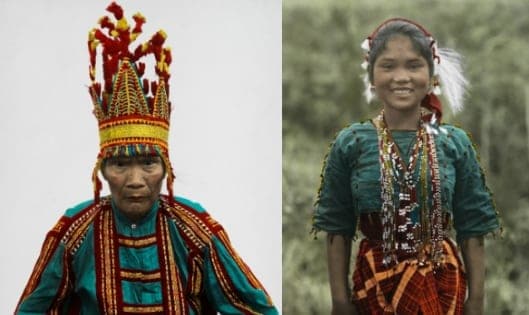
We now enjoy looking at a plethora of Filipino tribes photos from the 1900s, thanks in part to an American named Dean C. Worcester.
His journey to the Philippine islands started with scientific curiosity. In the late 19th century, he visited the country twice as part of a bird-watching expedition. Armed with a camera, Worcester and his companion went outside the realm of the flying creatures and took photographs of people they met along the way–from warriors and hunters to farmers and fishermen.
Also Read: 8 Dark Chapters of Filipino-American History We Rarely Talk About
Worcester’s rich experiences during these first few visits were later condensed into a book, The Philippine Islands and Their People, published in 1898 while he was an assistant professor of Zoology at the University of Michigan. It was well-received by the public, whose curiosity towards the exotic country only heightened after Spain ceded the Philippines to the US to the tune of $20 million.
Also Read: 7 Rare Photos From Philippine History You’ve Never Seen Before
US President William McKinley was among those who picked up his book, which then became Worcester’s ticket to be invited to the White House. A few conversations later, Worcester was appointed to the Philippine Commission, prompting him to return to the islands, where he served the position from 1899 to 1901.
Worcester went on to serve the Philippines for a few more years (1901 – 1913) as the secretary of the interior. This position saw him juggling many responsibilities in health, forestry, agriculture, and the “non-Christian tribes,” among others.
As part of his job, Worcester traveled the whole country, met its different inhabitants, and documented his experiences through photography. With the help of his assistant Charles Martin (who would later become the head of the National Geographic Society’s Photographic Laboratory), Worcester was able to give the American public a glimpse of the colorful life and culture of Philippine indigenous groups.
Also Read: From Mountain Boy to Governor: The Incredible Story of Pitapit
A fraction of Worcester’s extensive photographic collection appeared in full color in the November 27, 1913 issue of the National Geographic Magazine. A century later, NatGeo Creative enhanced these color photographs to benefit modern readers.
We’re displaying some of the best photographs from the collection with original descriptions written by Worcester.
1. Bagobo Women in Traditional Clothing
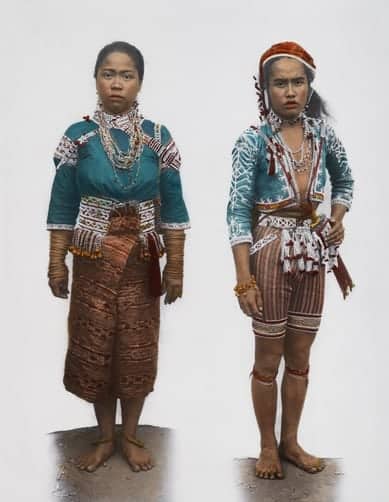
“On the west side of the Gulf of Davao, a deep indentation on the south coast of Mindanao, the large island at the south of the group forming the Philippines, live a primitive tribe called the Bagobos. They are remarkable for their picturesque costumes which are always gay with beads, bells and embroidery. Living in small villages, under chiefs called datus, they raise in their forest clearings, maize, rice and a very fine quality of hemp. The Bagobo men are remarkable for their effeminate profile and are with difficulty distinguished from the women.”
Also Read: Fantastic 116-Year-Old Color Pictures of the Philippines
2. A Bagobo Woman Wears a Skirt Indicating She Is the Wife of a Killer
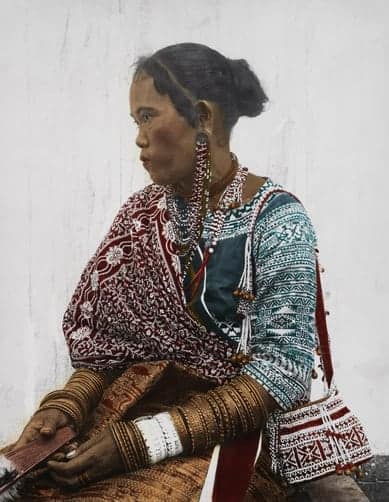
“The red and yellow skirt belongs only to the wife of a man killer but the rest of the costume is typical of the Bagobo women, especially the bell-decorated bag worn from the shoulder. The cheap European fan in her hand contrasts strangely with the curious bead pendant which hangs from ear to ear.”
Also Read: The Ancient Mindanao Deities of Philippine Mythology
3. A Bukidnon Warrior Poses With a Spear and Shield
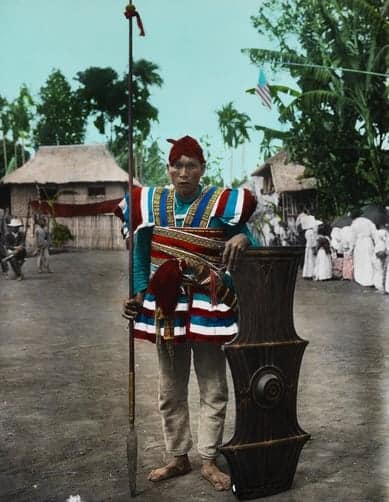
“He is ready for the fray. The upper part of his body is heavily padded as a protection against bolo cuts. The word Bukidnon means “people of the bukid,” or mountain forest and the tribe bearing this name seems to be descended from those natives who escaped conversion and have remained in the interior from the Spanish conquest till the present day.”
4. A Bukidnon Chief Wears a Head Ornament Indicating He Has Killed Men
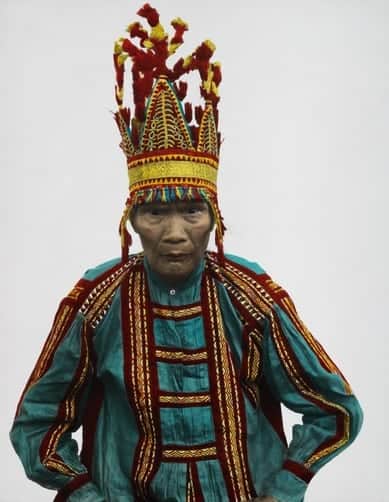
“Datus who have killed large numbers of enemies wear a most remarkable head ornament fashioned from cloth of gold, with elaborate scarlet, blue, or white tassels..no other Philippine tribe has anything in the least like it.”
Also Read: Meet the Terrifying Moro Warriors and Heroes of WWII
5. A Christian Bukidnon Belle
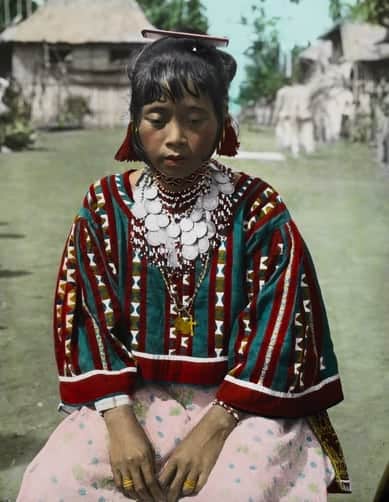
“Though most of the Bukidnon are still pagan there are a few who are Christian. To this number the girl shown in the picture belongs. Note the cross, and the two rosaries worn around the neck. The necklace is formed of silver coins. Spanish, English and Mexican pieces being represented. The extremely modern pink celluloid comb forms a curious finish to this otherwise picturesque costume.”
6. A Mandaya Warrior in Traditional Clothing Poses With His Weapons
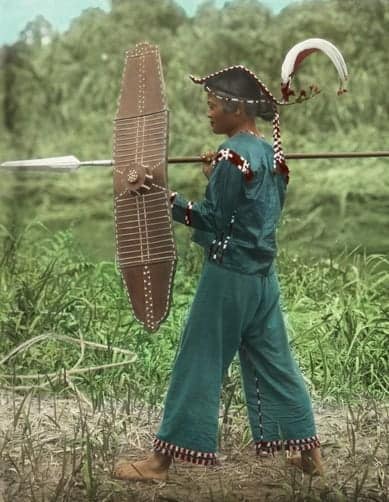
“There is a close affinity in manners and customs between the Mandaya and the Bagobos. Both are tribes from the Gulf of Davao in Mindanao, both offered human sacrifices, but the Mandaya as far as can be learned have never been cannibals. A death caused by accident or design is followed by a blood feud and a Mandayan will wait for years for an opportunity to spear or bolo his enemy. Freedom from the feud may be obtained by paying the “death price,” a sum in money or stock (usually a horse), equivalent to what they consider a man’s life to be worth. The Mandaya are about twice as numerous as the Bagobos, the tribe numbering some 30,000 souls.”
Related Article: 12 Surprising Facts You Didn’t Know About Pre-Colonial Philippines
7. A Mandaya Woman Holds Tobacco Between Her Lips To Blacken Her Teeth
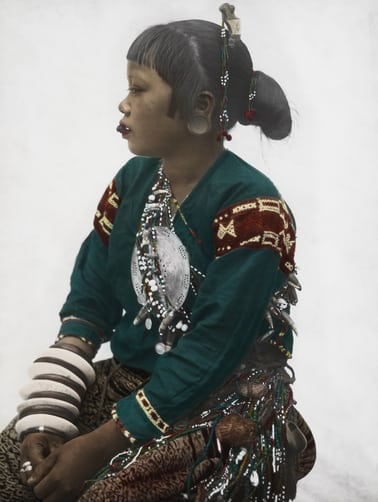
“Note the silver “patina” on her breast, and the load of armlets. The Mandaya women blacken their front teeth by holding a quid of tobacco and strongly acid leaves between teeth and lips.”
8. A Christian Manobo Woman in Traditional Clothing
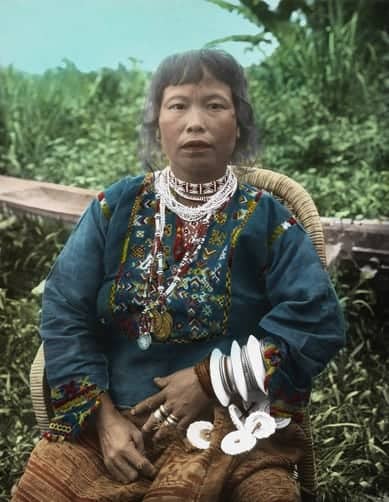
“The dress of some of the Manobo women is so like that of their Mandaya neighbors that at first sight it is hard to tell the difference. Both are very fond of the blue jacket and the contrast of the yellow or red skirt and both wear many heavy armlets. This is not surprising as the two tribes dwell next to each other and there is constant trading between them. This woman belongs to one of the few Christian settlements.”
Also Read: The Many Faces of Whang-od, Philippines’ Legendary Tattooist
9. A Lepanto Igorot Family Stand Outside Their House in Northern Luzon
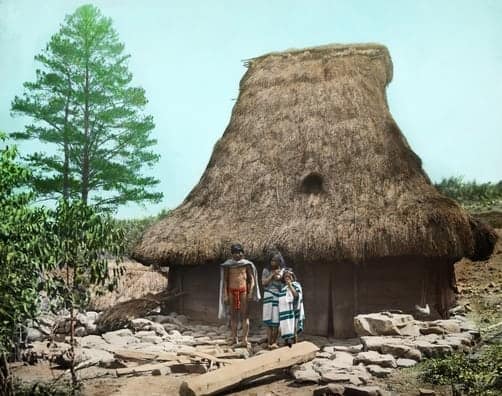
“Several distinct types of houses are found among the Igorots. The commonest type in Lepanto, shown here, has the curious high roof, within which is a storeroom. The floor is of dirt, enclosed by a wall of boards which does not reach up to the overhanging roof. The inhabitants have individual sleeping boards which they lay on the damp ground. Some of the Lepanto Igorots have even more primitive houses than this, being made of nothing more substantial than grass. On the whole the Igorots are an exceedingly filthy people, but of late years, they have shown a tendency to improve in this respect.”
10. A Lubuagan Igorot House
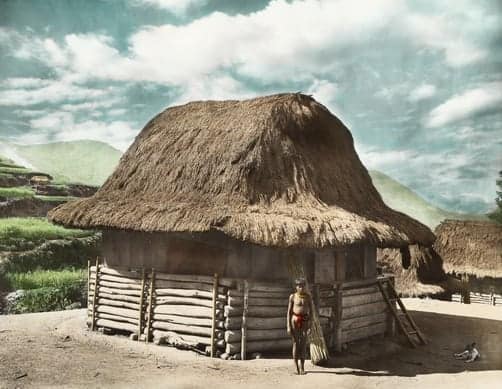
“This picture shows one of the better types of Igorot dwelling, built on piles and obtaining better ventilation by being elevated above the ground. The floors laid with split bamboo are far more sanitary and comfortable than those made of earth. The pig pen–an important feature in an Igorot village–is a sunken pit on one side of the house, near which is a hole through which the animals can retreat to the walled-in space beneath the floor of the dwelling.”
Also Read: The Adventures of Antero, An Igorot Boy Sensation Who Met President Roosevelt
11. A Manobo Woman in Traditional Clothing
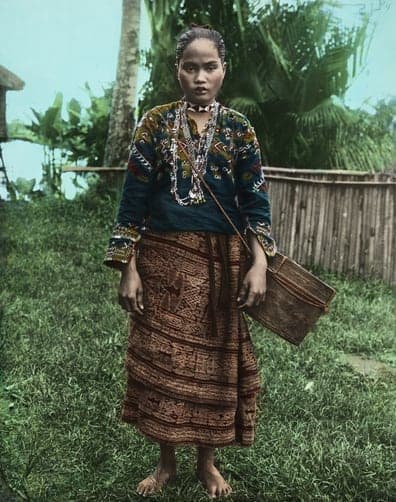
“The Manobos are believed to number about 60,000 people of whom some 2,000 are civilized. The latter are found in the province of Davao and most of them are Christians. They are the result of the activity of the Jesuits, who, in the last years of the Spanish rule, formed settlements for their converts and taught them how to till the soil.”
12. Subanon Woman Holding Her Child
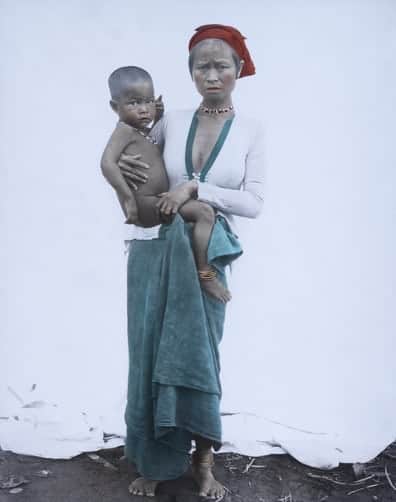
“The Subanos, numbering about 30,000, live in the western part of Mindanao and are completely dominated by their Moro neighbors to whom they pay tribute. They are a timid industrious folk, the men are capable agriculturists and the women are skillful weavers and basket makers. At about the age of 15, both men and women commence to file and blacken their teeth which in about 10 years are ground down to the gums.”
Also Read: 10 Reasons Why Life Was Better In Pre-Colonial Philippines
13. A High-Ranking Moro Man (Datu) Poses in Traditional Clothing
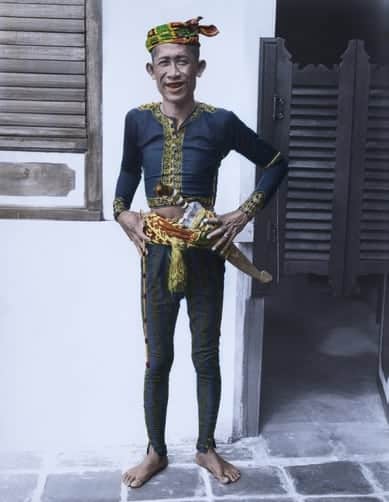
“The Moros are a Mohammedan people, governed by sultans of their own, called datus, who seem to exercise an almost unlimited power and are notorious for their cruelty and extortion. The datus have given endless trouble to the American authorities.”
14. A Mangyan Man and Woman in Traditional Clothing
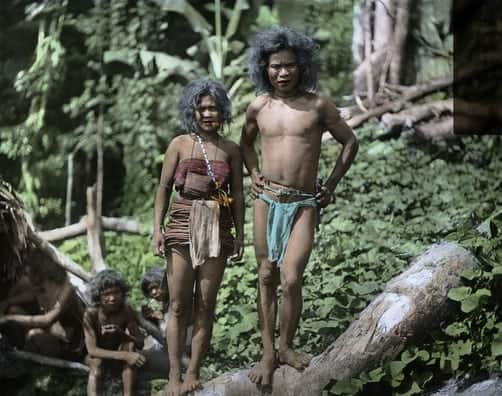
“This is a wild people of the mountains of Mindoro, very much lighter in color than other Filipino tribes. This is probably due to the fact that they have lived for generations in the depths of the forests, though there is a tradition, probably of no value, that they are descendants of some white race. They are a nomadic people having no idea of agriculture or of the value of money. Exceedingly timid, they take to flight on the approach of a stranger.”
Also Read: The Tasaday tribe and other shocking hoaxes in Philippine history
15. Ilongot Woman and Girls Pose on a Bamboo Platform
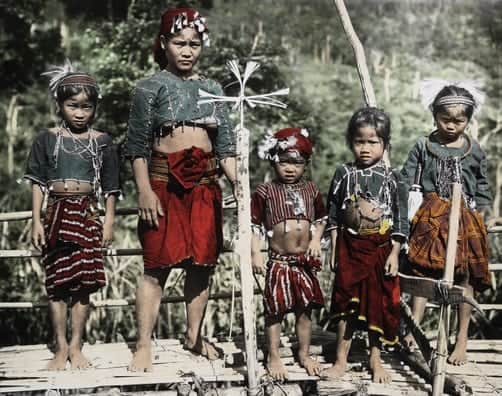
“The Ilongots are a small tribe, probably less than 6,000 in number, living in northern Luzon. They are forest dwellers in the strictest sense of the term, living in small groups in the woods and moving their villages very frequently. They build fairly large bamboo houses of primitive design, elevated from 6 to 9 feet above the ground, before the door there is usually a wide bamboo platform like that shown in the picture.”
16. Tagakaolo Man in Traditional Garb Holding Knife at Waist
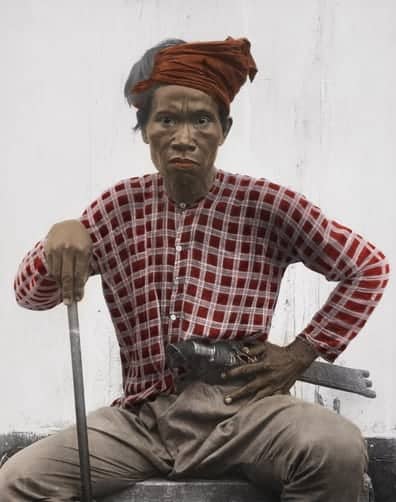
“Living to the south of the Bagobos on the west side of the Gulf of Davao in Mindanao are the Tagakaolo, a small tribe having a height greater and a physique finer than most of the tribes of that island. Little or nothing is known about them.”
17. A Lubuagan Igorot Woman in Traditional Clothing
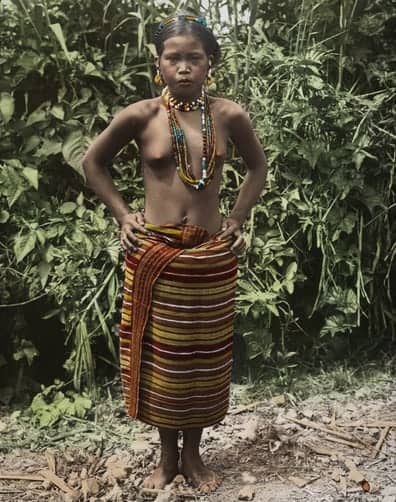
“Her skirt bulges out at the waist where it is supported by a “form improver” made of woven rattan. Members of this tribe are often referred to as Kalingas, but they differ from that race in certain essential particulars, although they probably have a good proportion of Kalinga blood.”
Also Read: The Short And Tragic Life of The First Igorota Beauty Queen
18. A Young Ilongot Woman Smiles for a Portrait
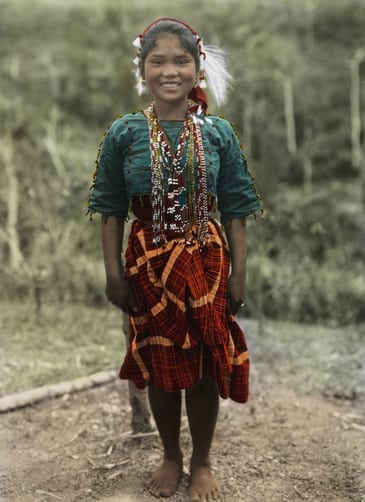
“The Ilongot women show great ingenuity in their dress considering the fact that they belong to a tribe so primitive that they are unable to count beyond ten. They embroider with surprising skill, and fashion elaborate necklaces and girdles of cowries strung on colored cloth. Bells are greatly prized by both men and women and are worn at the girdle or hanging from the necklace. Head ornaments of white horse hair are their passion and they will go to any length to obtain the coveted material, which they use very tastefully as can be seen from the picture.”
Also Read: 10 Fascinating Pinoy Vintage Photos on Amazon.com
19. Tiruray Women in Traditional Clothing
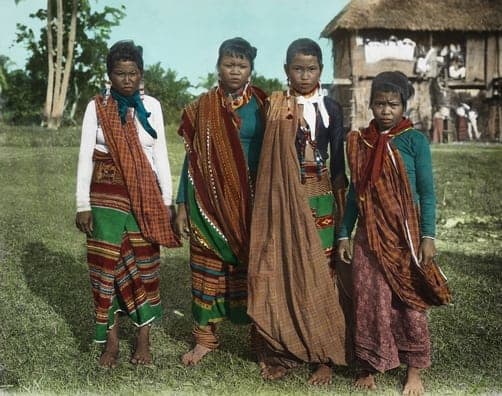
“In the west of Mindanao is a small tribe called the Tiruray, who dwell between the Moros and the Bilans. They do not understand the arts of spinning and weaving and so depend upon their Moro neighbors for their clothes. The women wear sarong or loose skirt with a very tight jacket. Around the waist are girdles of spinal brass pieces embellished with beads, and their ankles are loaded with brass rings. They blacken and file the teeth and frequently color their lips a vivid red. The tribe is poor, having no industries, and depend upon their crops of rice, corn and sweet potatoes, which they produce by the most primitive and laborious methods of husbandry.”
20. A Tinggian Girl in Mourning
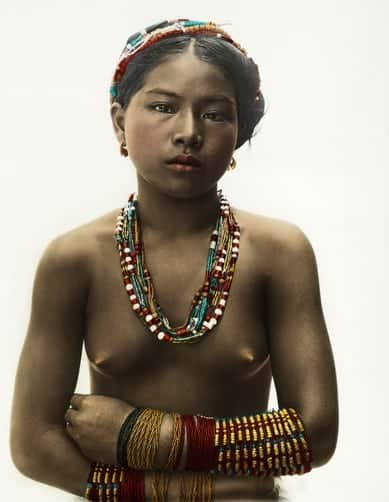
“She belongs to the more civilized branch of the tribe. Note her peculiar arm ornaments and the constriction of the forearm which they produce. This is considered very beautiful.”
21. An Ilongot Family in Traditional Clothing Poses for a Portrait
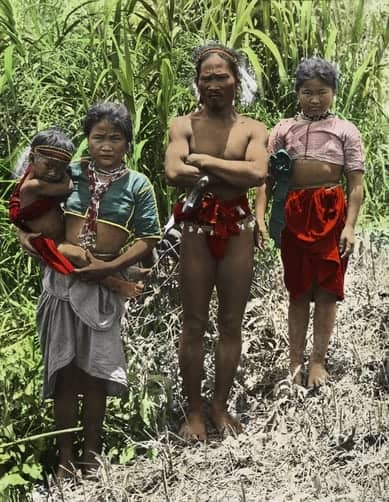
“Unlike the women who are rather partial to clothes, the Ilongot man seldom wears more than a loin cloth. He is a skillful hunter depending on the chase for his supply of meat, and with bow and arrow tracks down deer and wild hogs which are abundant. Agriculture is left to the women who grow sweet potatoes, the principal article of food, a little rice, corn and bananas. The men distill a kind of rum from the sugar cane and are very fond of intoxicating liquor. Each village is generally at war with the next and fighting is conducted by ambush, never in the open. Poisoned arrows are used and they set spiked bamboos and spring guns for their enemies in places which are likely to be crossed.”
Also Read: When Filipino Underdogs Made History At A US President’s Inauguration
22. A Tinggian Tribesman Wears a Waterproof Cape Made of Plaited Straw
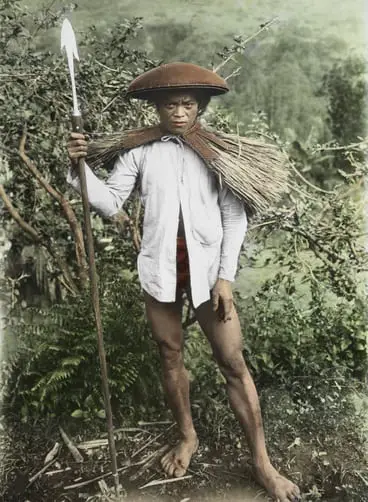
“Although a comparatively civilized race, the Tingians have been classed as head hunters, for generations they have had to fight for their existence against the Igorots and the Kalingas and they may have acquired this habit from their enemies. They show great skill in the use of the lance a typical example being shown in the picture. Note the curious hat and the waterproof cape made of plaited straw.”
23. A Young Moro Boy Sits on the Knee of an American Lieutenant
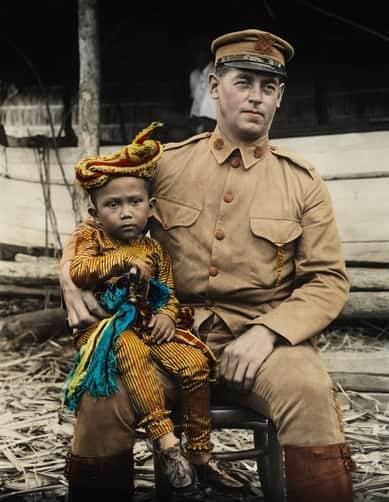
“The son of Datu Bata Rasa seated on the knee of captain E.G. Miller, who lost his life while serving as Governor of Palawan. The Moros are found in their greatest strength in the Island of Mindanao and the Sulu Archipelago. They are unexcelled pirates and slave traders, treacherous and unreliable to the last degree. The whole race numbers about 300,000 has never been brought under complete control and its pacification presents one of the most difficult problems before the Philippine government.”
Also Read: Early Filipino warriors used drugs to enhance their killing capabilities (or did they?)
24. Villagers Group Together in a Small Tinggian Igorot Village
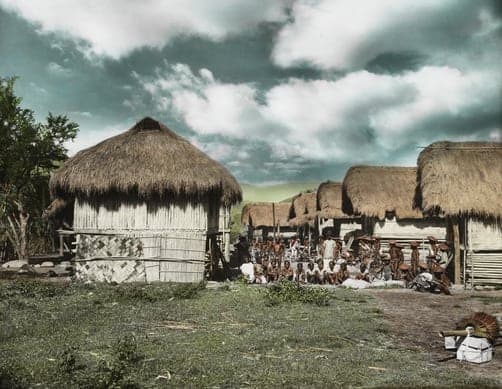
“Although they cling tenaciously to the beliefs of their forefathers, the Tingians are in many respects as highly civilized as many of their Christian neighbors. As befits one of the cleanest peoples their well built villages are always placed on high, sanitary sites and the inhabitants are an orderly, law abiding folk. This tribe are skillful agriculturists and raise horses and cattle for the market and in consequence many of them are fairly well-to-do.”
Also Read: An Isolated Filipino Tribe Who Live Inside A Volcano Crater
25. A Kalinga Couple in Traditional Dress
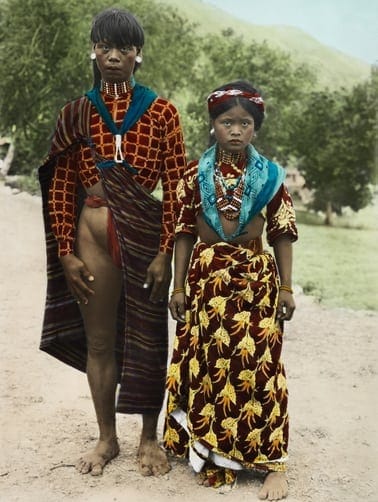
“These people are the Peacocks of the Philippines. They revel in the brightest colors and bedeck themselves in large figured, gaudily colored cotton fabrics. The women have skirts reaching well below the knees and are often loaded with necklaces of agate beads which they greatly prize. on state occasions, the men ornament their hair with tufts of scarlet feathers and bunches of hibiscus flowers or marigolds. Note the small waist of the man.”
Also Read: Rare Color Photos of the Philippines in the 1950s
26. Ifugao Houses Designed To Prevent Small Animals From Entering
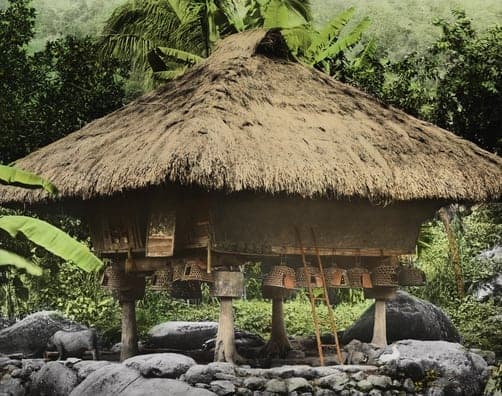
Also Read: Rare Color Photos of the Philippines in the 1940s
27. An Ifugao Warrior Poses With a Shield and Spear for a Portrait
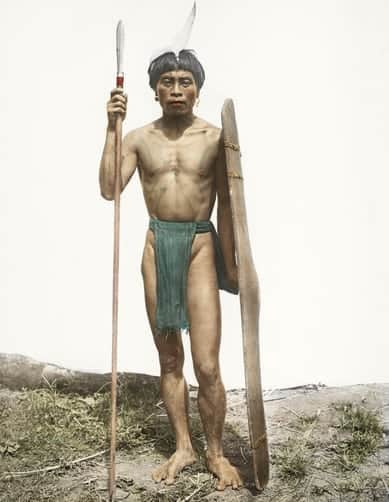
Also Read: The Oldest Known Photos of the Philippines Ever Taken
28. Four Benguet Igorot Schoolgirls Pose for a Portrait in Northern Luzon
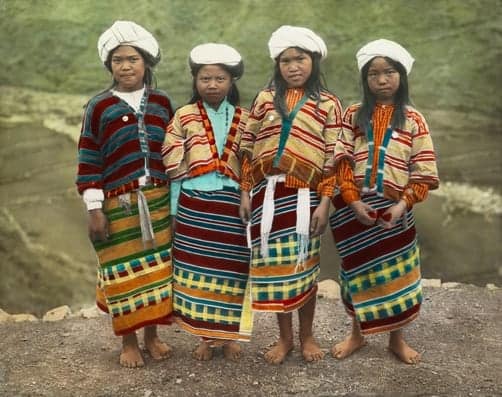
References
Capozzola, C. (2012). Photography and Power in the Colonial Philippines. Massachusetts Institute of Technology (MIT) Visualizing Cultures. Retrieved 5 August 2016, from http://goo.gl/Ih9asc
Worcester, D. (1913). The Non-Christian Peoples of the Philippine Islands. National Geographic, (11).
Written by Luisito Batongbakal Jr.
Luisito Batongbakal Jr.
Luisito E. Batongbakal Jr. is the founder, editor, and chief content strategist of FilipiKnow, a leading online portal for free educational, Filipino-centric content. His curiosity and passion for learning have helped millions of Filipinos around the world get access to free insightful and practical information at the touch of their fingertips. With him at the helm, FilipiKnow has won numerous awards including the Top 10 Emerging Influential Blogs 2013, the 2015 Globe Tatt Awards, and the 2015 Philippine Bloggys Awards.
Copyright Notice
All materials contained on this site are protected by the Republic of the Philippines copyright law and may not be reproduced, distributed, transmitted, displayed, published, or broadcast without the prior written permission of filipiknow.net or in the case of third party materials, the owner of that content. You may not alter or remove any trademark, copyright, or other notice from copies of the content. Be warned that we have already reported and helped terminate several websites and YouTube channels for blatantly stealing our content. If you wish to use filipiknow.net content for commercial purposes, such as for content syndication, etc., please contact us at legal(at)filipiknow(dot)net
